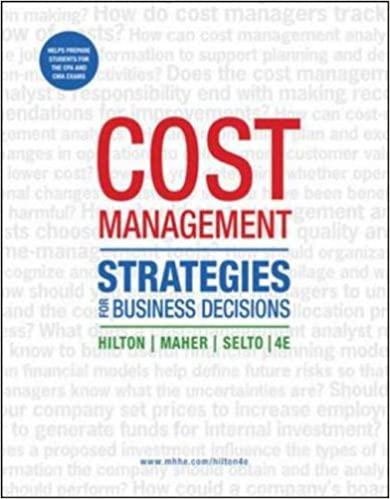Sparkle Company makes three types of sunglasses: Stars, Geeks, and Fashions. Sparkle presently Limitations of Traditional applies
Question:
Sparkle Company makes three types of sunglasses: Stars, Geeks, and Fashions. Sparkle presently Limitations of Traditional applies overhead using a predetermined rate based on direct-labor hours. A group of company employ-
Costing Methods ees recommended that Sparkle switch to activity-based costing and identified the following activities,
(LO 1,4,5) cost drivers, estimated costs, and estimated cost-driver units for year 2 for each activity center.
Recommended Estimated Estimated Cost-
Activity Cost-Driver Base Costs Driver Units Production setup Numbero f production runs $ 80,000 200 runs Order processing Number of orders 160,000 200 orders Material handling Number of pounds of material 40,000 8,000 pounds Equipment depreciation Number of machine hours 140,000 10,000 hours and maintenance Quality management Number of inspections 100,000 40 inspections Packing and shipping Number of units shipped 80,000 20,000 units In addition, management estimated 2,000 direct-labor hours for year 2.
Assume that the following activities occurred in February of year 2:
Stars Geeks Fashions Number of units produced ........4.... 1,000 500 400 DircotmiateilalicOsts aan uae ana nee $4,000 $2,500 $2,000 Direetlaper hOuvs) yh sor. cans 4. aaa 100 120 110 Numb eHORONGEIS ai veet 60 te os a 8 8 4
~ Number of productionruns............. 4 8 16 Number of pounds of material .......... 400 200 200 Number of machine hours ............. 500 300 300 Numberofinspectionsiv:........ 289 2 2 2 Number of units shipped .............. 1,000 500 300 Direct-labor costs were $20 per hour.
Required
a. (1) Compute a predetermined overhead rate for year 2 for each cost driver recommended by the employees. (2) Also compute a predetermined overhead rate using direct-labor hours as the allocation base.
b. Compute the production costs for each product for February using direct-labor hours as the allocation base and the predetermined rate computed in requirement (a.2).
c. Compute the production costs for each product for February using the cost drivers recommended by the employees and the predetermined rates computed in requirement (a.1). (Note: Do not assume that total overhead applied to products in February will be the same for activity-based costing as it was for the labor-hour-based allocation.)
d. Management has seen your numbers and wants to know how you account for the discrepancy between the product costs using direct-labor hours as the allocation base and the product costs using activity-based costing. Write a brief response to management.
Step by Step Answer:

Cost Management Strategies For Business Decisions
ISBN: 12
4th Edition
Authors: Ronald Hilton, Michael Maher, Frank Selto





